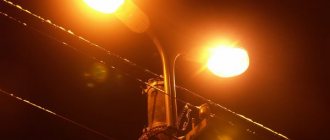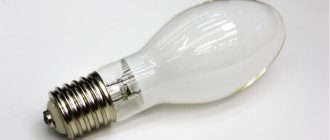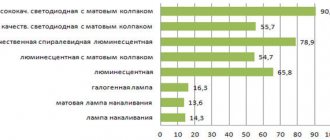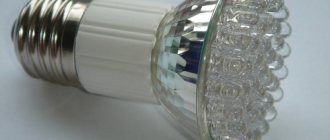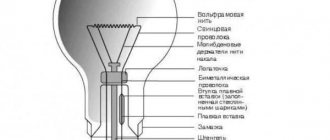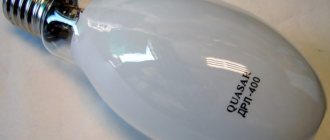Principle of operation
The inside of the flask is filled with a mixture of gases and contains an aluminum oxide burner. This is where all the work of the lamp takes place.
The connection principle is shown in the diagram
The sodium lamp has a simple design and simple principle.
- After switching on, the built-in ignition device begins to generate pulses;
- An arcing electronic charge is formed in sodium vapor, which causes the vapor to begin to glow. The light comes on;
- The burner gradually warms up and the light becomes brighter;
- In modern lamps, a choke is built into the design, which limits the arc current and ensures an uninterrupted supply of current.
Advantages and disadvantages
HPS lamps have a large number of advantages, thanks to which they remain in demand today. Among its advantages:
- High level of light output compared to other light bulb models. High pressure lamps give up to 150-160 lm/W, low pressure lamps - up to 200 lm/W;
- Efficiency reaches 30%;
The lamp produces a strong yellow light
- A wide range of temperatures at which the light bulbs operate: from −60 to +40 degrees. In this case, the lamp lights up even at low temperatures;
- Long period of operation: minimum period - 10-12 thousand hours, maximum - up to 30-32 thousand;
- Cost-effective: HPS consumes 1.5-2 times less electricity. The production of lamps is also inexpensive: it has been established for a long time and works well, expensive materials are not required;
- Anti-fog effect: yellow and orange colors are poorly absorbed by water, and therefore lamps with such lighting are better visible in rain and fog.
However, the disadvantages of DNAT are no less significant:
- Weak color rendering: all lamps have a pronounced yellow or orange color. Lamps cannot be used in residential premises;
- Long burn-up: the first 5-10 minutes the lamp burns weakly while it warms up;
The light bulb contains mercury, which makes it dangerous.
- Certain electrical requirements. Lamps can only be used in networks with a fairly stable voltage;
Important! The second option is to use high-quality chokes
- Presence of mercury: for disposal, lamps must be taken to a special collection point. A broken lamp can be dangerous if removed incorrectly or not thoroughly;
- Temperature: despite the fact that HPS lamps can operate at −60 degrees, the optimal temperature for them is from −20 to +30 degrees. At higher or lower temperatures, the light output will be lower and the service life will be reduced;
- The presence of quite strong ripples, they can reach 50 Hz. This results in constant flickering, which is tiring for the eyes.
Possible malfunctions
There are basic mistakes when connecting a lamp:
- The four-pin inductor is not connected correctly. Many people apply voltage to some contacts and connect a lamp to others. This is incorrect; before connecting the lamp, you should study the diagram on its body.
- Screw in the lamp with bare hands. This affects the reliability of the lamp. If touching does occur, it must be wiped with a clean, dry cotton cloth before starting.
- Using the wrong throttle. If the value exceeds the specified value, more current will flow through the lamp. In this case, the lamp will overheat and will periodically light up and go out.
- Flashing may be due to voltage fluctuations. For normal operation, the voltage range should be 220 V +/- 5%.
- Using a choke for the wrong lamp. If you turn on the HPS through the throttle of the DRL device, the operating time of the lamp will be reduced.
- Not using a capacitor. In this case, the wires will constantly overheat.
- Breakdowns in the wire from the lamp to the IZU. In this case, a crackling sound comes from the IZU, but the lamp itself does not light up. It is advised to replace the wires and check the condition of the contacts on the IZU.
- Problem with IZU. The lamp does not light up, the IZU does not make any sounds. It is advised to check the ballast with an Ohm meter or replace the IZU.
When working with a HPS lighting device, you must follow a number of safety precautions:
- after turning off the lamp, do not touch it for 15 minutes until it cools down completely;
- do not touch the device without gloves;
- the device requires constant ventilation to operate;
- Light bulbs should not be placed near flammable structures;
- It is required to observe general safety precautions when working with electrical appliances.
If you operate the lamp correctly and ensure that the lamp is connected correctly, stable operation can be guaranteed.
Application area
It is impossible to list all areas of application of DNAT. They can be seen in road lighting, in train stations and airports, and in warehouses. The choice of HPS lamp depends on where it will be used. For use in greenhouses, nurseries and flower beds, it is recommended to use HPS 150 or 250 W
When using a 400 W bulb, it is important to maintain distance between plants and lamps. It must be at least 50 cm
A simple method for selecting key transistors for switching power supplies
For street lighting, industrial premises and underground passages, 150 W lamps are used. Also, the light source must be in a protected housing with a dust and moisture resistance index of at least IP65. The lamps have an anti-fog effect, so they provide good visibility even in bad weather.
The largest manufacturers of HPS lamps are Philips, Osram, General Electric.
Application area
Depending on the type of lamps, their areas of application are also distinguished.
The use of these devices in the agricultural sector is associated with the peculiarity of their spectrum, which is very close to ultraviolet radiation. In greenhouses, plant nurseries and flower beds, manufacturers recommend using 150 W or 250 W HPS lamps. If you use HPS 400 W, then you must remember the minimum distance between the device and the plant (50 meters). When installing street lamps, as well as devices for sports complexes, tunnels and passages, HPS 70 W and 150 W are most often used. One of the conditions for successful operation in this case is the presence of protection from moisture and dust.
As for the quality of color rendering, in this parameter sodium arc lamps are inferior to LED spotlights. HPS 150 W has a color rendering index of 20-30 Ra. For cold LED lamps it is 80 Ra, and for warm ones it is 90-100 Ra. LEDs also benefit in terms of contrast.
Application of a HPS lamp
As already mentioned, if we put aside all sorts of perversions, HPS lamps are used mainly in lamps for lighting roads and for supplementary illumination of plants.
Road lighting
The main reason why road workers are hooked on HPS lamps is their incredible energy efficiency and unpretentiousness. Now, of course, a parameter of 100...130 lm/W from a lamp will not surprise anyone, but in the middle of the last century it was a breakthrough.
But the funny thing is that this light source at that time was not the most energy efficient. HPS lamps were high pressure sodium lamps (HPS). And their predecessor - a low-pressure sodium lamp (LPNS) - doubled the light output of a newborn. That is, it produced up to 200 lm/W (by the way, this is still an almost unattainable result, even for LEDs in mass production and at an affordable price).
Actually, the ancestor of the HPS lamp is the low-pressure sodium lamp
But NLND had an even narrower spectrum (well, completely crimson-orange), so the market simply turned a blind eye to such minor losses and accepted the new lamp with open arms, because the colors of objects in its rays became at least somehow distinguishable.
Most highways, open parking lots, and interchanges all over the world are now illuminated with HPS lamps. Actually, here it is:
Non-illusory proof of the involvement of the HPS lamp in illuminating everything
… and so:
HPS lamps illuminate almost 100% of roads
As, again, already mentioned, luminaires for HPS lamps are produced all over the world by hundreds (maybe thousands) of companies. In Russia, housing and communal services have become the most common. This is also terminology dating back to Soviet times, when everything, including product names, was standardized and regulated. ZHKU stands for “ZH” Console Street. “F” is not deciphered in any way, because this letter is simply assigned to designate sodium lamps. Why "F"? There is probably some explanation for this, but it certainly doesn’t fit with ordinary logic. GKU - “G”, metal halogen lamp - understandable. RKU - “R”, Mercury lamp - understandable. DKU - “D”, LEDs - understandable. Housing and communal services... it’s not clear. Let’s simply associate this with a color close to DNAT – Yellow.
A very typical housing and communal services lamp for a DNAT 150 lamp
There are a lot of options for housing and utility services and their manufacturers in Russia. But the leader in the production of Russian utility lamps is Galad, Reflax and Lighting Technologies. How are the leaders? No one thought this, they were just on everyone’s lips. Moreover, Reflux also produces HPS lamps. But we'll talk about this below. There are also countless other manufacturers who import utility housings from Asian countries and sell them in Russia under their own brand.
HPS lamps for additional illumination of plants
By the way, this is a huge, vast topic for holivars on these Internets of ours. What is better for lighting parsley or tomatoes - sodium light or LED? Perhaps we will drop this topic now. But let us note: without exception, all greenhouses in the world, with the exception of experimental ones, and also without taking into account the manual labor of home gardeners, are illuminated with sodium and only with it.
Light for plants
Moreover, greenhouse lamps designed for HPS lamps, as a rule, do not require any serious bodywork in the form of tempered glass, IP housings and other clutter. As a result, a lamp with ballasts, base and reflector weighs 2 times less than their street counterparts.
HPS lamps guard the greenhouse economy
So that you understand what an LED lamp looks like, replacing HPS 1000 lamps, the CREE company has released an analogue of 1 kW HPS. Now there is a lot of discussion on the forums - will the load-bearing structure of the greenhouse withstand such a load, and in general, is it analogous? To be fair, we note that this is the so-called. Reference design is an attempt to show the capabilities of LEDs using a specific example with measurements and calculations, and not a finished product.
Experimental farms for illuminating seedlings with LEDs
Why is the transformer humming?
The operation of a transformer is often accompanied by a characteristic hum. This phenomenon should not be considered abnormal, since the noise is caused by physical processes occurring in the device.
But sometimes a high noise level indicates problems with the device, especially if we are talking about a household transformer in the power supply or amplifier.
Let's consider the causes of noise and options for solving the problem if the hum is associated with a malfunction of the device.
LED lamp sockets
About the operating principle of the transformer
During operation, the transformer transforms the characteristics of electric current or voltage, increasing or decreasing the specified parameters, depending on the conditions required by the consumer.
The device consists of the following components:
- core;
- primary winding;
- secondary winding.
Transformer operating principle
The core is made up of individual plates formed into a package. When current flows through the primary circuit, a magnetic field is formed, which excites current in the secondary winding.
Main causes of hum
Magnetostriction is the effect of changing the size of a body that allows charged particles to pass through it. This is typical for magnetic field sensitive materials used to make the core.
As a result of this effect, the process of functioning of the device is accompanied by sound waves of a certain frequency - buzzing.
In addition to magnetostriction, the causes of noise can be:
- working oil pumps
- fans of cooling systems of powerful transformers,
- eddy currents (Foucault currents) are called electric currents that arise due to electromagnetic induction in a conducting medium when the magnetic flux penetrating it changes. Eddy currents generate their own magnetic fluxes, which, according to Lenz's rule, counteract the magnetic flux of the coil and weaken it,
Electrodynamic forces in the windings and electromechanical devices that regulate voltage under load also create noise.
Factors affecting hum level
A humming sound occurs if the unit operates in certain modes. During one cycle of operation of the transformer, tension and compression of the core occurs twice. If the mains frequency is standard with alternating current (50 Hz), the device begins to hum.
Pra
The hum of power transformers. Norms and reasons for its occurrence
Also read: Purpose of voltage indicators
The frequency of sound is twice that of electric current.
The strength of the transformer hum is determined by the following factors:
- Degree of workload;
- Overall dimensions of the constituent elements;
- Physical characteristics, material used to manufacture the magnetic core.
The hum may occur due to the following design features of the transformer:
- the effect of magnetic flux tends to move the windings of the device relative to the magnetic core. If the coil is not wound tightly enough, vibration occurs due to the loose fit of the turns with a corresponding hum (the black arrow shows the coil);
- If the core plates are poorly fitted, gaps appear between them. During operation, the vibration of the plates is accompanied by a characteristic metallic ringing, turning into a buzzing sound (the red arrow shows the core plates);
- if the copper wires of the windings are defective or damaged, the coil may spark, with popping noises with each spark. Powerful discharges are characterized by a more intense sound;
- The individual parts in the device are not sufficiently secured, resulting in vibration and noise.
A strong hum is typical of power transformers used in industrial production. But if the operation of a low-power household appliance begins to be accompanied by a significant hum, this is a reason to carry out diagnostics in order to identify and eliminate the malfunction.
Transformer testing and troubleshooting
Diagnostics will help identify the cause of the problem and eliminate the malfunction. Interturn closure is determined by external inspection. If damage to the insulating layer and dark marks on the winding are observed, this indicates the specified problem.
In this case, the device needs to rewind the coils.
If the external examination does not produce results, a more in-depth study will be required.
If you have a multimeter, you can do the following:
- In megohmmeter mode, insulation resistance measurements are taken and compared with the standard values given in the reference literature. If the actual value exceeds the nominal value by more than 50 percent, this indicates the presence of an interturn short circuit;
- A similar measurement is carried out for a technically sound device. A discrepancy of more than 20 percent indicates a malfunction.
Also read: Why does the LED light blink when the lights are off?
When studying a step-down device, you can measure the voltage value for the output winding by connecting the device to the network. If smoke or crackling appears when turned on, the device should be turned off immediately - this indicates a failure of the primary coil.
Often a self-rewinding transformer begins to hum. This happens for the following reasons:
- the core is incorrectly assembled or not tightly fitted - it should be arranged tightly, check the tightness of the connection of the plates;
- the winding is not secured enough - the coil needs to be strengthened;
- gaps between the turns of the winding - the coil is impregnated with paraffin, filling the gaps;
- The number of turns is incorrectly calculated - rewinding will have to be done again.
In order for the transformer to work correctly after repair, the work must be performed by a professional. If you do not have the appropriate knowledge, skills and experience, you should not interfere with the device.
If a strong hum appears during operation of the transformer, it is necessary to carry out diagnostics. Otherwise, continued use of the device may result in failure, jeopardizing the safe operation of other equipment.
Calculated greenhouse lighting lamps Reflux DNAT / DNAZ
Information about the material Updated: June 14, 2016
- Seal
Table of calculated illumination levels for phytolights, irradiators with Reflux Dna3 lamps (with a mirror reflector) depending on the lamp power, the distance from the lamp to the tops of plants and from the illuminated surface.
The table is intended for an approximate calculation of greenhouse lighting and selection of the required number of DnaZ . Please note that the data in the table is for lighting greenhouses in groups, not with one lamp. The overlap of light fluxes from adjacent lamps is taken into account.
| Phytolamp | Power, W | Distance from lamp to plant tops, m | Lighting area, sq.m. | Size of illuminated area, m | Illumination level, Lux |
| Reflux / DNAZ | 70 | 0.4 | 1.0 | 0.7×1.5 | 4000-5000 |
| 0.5 | 1.36 | 0.8×1.7 | 3500-4000 | ||
| 0.6 | 2.0 | 1.0×2.0 | 2200-2500 | ||
| 0.7 | 2.4 | 1.2×2.0 | 1800-2000 | ||
| Reflux / DNAZ | 100 | 0.5 | 1.5 | 1.7×0.9 | 4000-6000 |
| 0.7 | 2.0 | 1.9×1.1 | 2500-4500 | ||
| Reflux / DNAZ | 150 | 0.7 | 2.0 | 1.9×1.1 | 5000-7000 |
| 1.0 | 2.5 | 2.1×1.2 | 3500-5500 | ||
| 1.5 | 3.0 | 2.3×1.3 | 2500-4500 | ||
| Reflux / DNAZ | 250 | 1.0 | 3.0 | 2.3×1.3 | 5500-8500 |
| 1.5 | 3.5 | 2.5×1.4 | 3000-5000 | ||
| 1.7 | 4.0 | 2.7×1.5 | 2000-4000 | ||
| Reflux / DNAZ | 400 | 1.5 | 4.0 | 2.5×1.6 | 5500-7500 |
| 1.7 | 6.0 | 3.0×2.0 | 3500-5500 | ||
| 2.0 | 8.0 | 3.4×2.3 | 2500-4500 |
Pros and cons of HPS lamps
Advantages:
- high level of efficiency;
- high light output;
- unlike metal halide devices, sodium lamps can operate in any position;
- low cost;
- light weight;
- resistance to moisture, vibration, mechanical shock;
- economic benefit;
- anti-fog effect.
Flaws:
- may begin to flash towards the end of its service life;
- low color rendering index;
- high ripple factor;
- high operating temperature;
- does not work at low temperatures;
- long ignition time;
- Special operating conditions are required due to the risk of explosion and mercury content in the composition.
Despite their shortcomings, about 95% of roads are illuminated with HPS lamps.
Review of the DNAT 400 lamp
Main conclusions
HPS sodium lamps are the most used light sources for highways, stadiums, train stations and other facilities where resistance to weather conditions is important.
The sodium arc tube lamp is unique in its kind, although it has its drawbacks, the main ones being color distortion and difficulty in disposal. But good brightness, minimal energy consumption and durability take it to a leading position among lighting devices.
Connecting a lamp is more difficult than similar lighting devices; you need to have certain skills and abilities. It is important to follow the connection diagram and select all components correctly.
Operating principle and connection diagram of a HPS lamp
An arc discharge is maintained inside the torch. For its appearance, IZU is used. This abbreviation stands for pulse ignition device. When the circuit is turned on, the lamp receives a pulse from 2 to 5 kV. It is needed to start the lamp - electrical breakdown of the burner and the formation of an arc discharge. The ignition voltage is significantly higher than the combustion voltage. Typically, three to five minutes of energy are spent to heat up the burner. At this moment the brightness is still low. Returning to normal operating mode takes no more than 10-12 minutes, while the brightness increases and normalizes. In the diagram, L is phase (line), N is zero.
The circuit contains an IZU and an inductor as a ballast element. Usually the connection diagram is present on the body of the throttle and/or pulse ignition device.
Sometimes a non-polar capacitor may be added to the circuit. Typically a capacitance of 18-40 µF is used. It is not necessary; adding it will not make the lamp shine brighter. Its task is phase compensation. The fact is that the circuit consumes active and reactive power, since there is a choke. There is no benefit from the reactive component, but the harm is obvious - interference in the power supply and reduced energy efficiency. However, adding capacitance to an electrical circuit will not improve energy efficiency. Adding a capacitor will somewhat reduce inrush currents and prevent irreversible degradation of the electrodes.
The capacitor used is selected based on the power of the lamp. Recommendations are presented in the table.
| HPS lamps | |
| Lamp power, W | Parallel connected capacitor 250 V, µF |
| DNAT-70 1.0A | 10 µF |
| DNAT-100 1.2A | 15-20 µF |
| DNAT-150 1.8A | 20-25 uF |
| DNAT-250 3A | 35 µF |
| DNAT-400 4.4A | 45 µF |
| DNAT-1000 8.2A | 150-160 uF |
When assembling a lamp using HPS lamps yourself, it is not advisable to use a wire longer than one meter between the socket and the igniter.
NLVDs are very sensitive to the quality of the power supply. When the voltage drops by 5-10 percent, the luminous flux can drop by a third. Increased voltage significantly reduces service life.
The IZUs for dnat (pulse ignition devices) themselves can have either two or three contacts. There's no difference. Not one of these options is worse or better than the other - both provide the same operating conditions for the lamp.
There is also a type of lamps that do not require an IZU. This is DNAS. They can be recognized by the starting antenna near the burner. It is usually made from one or two turns of wire that wraps around the burner.
Connection diagram
Difficulties may arise when connecting the device. It is not enough to simply apply voltage - the lamp has a high resistance and will not start. To organize the starting impulse, an IZU is used. There are pulse ignition devices with temperature sensors and a digital timer.
An electromagnetic or electronic ballast is used to limit the amount of current passing through the bulb. An electromagnetic ballast (EMG) is a coil with an open magnetic circuit (choke). An electronic ballast (EPG) is an electronic circuit - a current limiter. The choke is connected in series with the lamp, the IZU is connected in parallel.
There are two types of IZU:
- two-pin – easy to connect, cheap;
- three-pin – makes the circuit work correctly.
When working with a two-terminal IZU, the discharge is applied to the lamp and ballast, and in the case of a three-terminal IZU - only to the lamp.
Important! It is not recommended to use two-contact IZUs, as they can break through the insulation of the ballast.
The HPS connection diagram is usually depicted on the device. The ballast must be connected out of phase. When connecting the IZU, you must ensure that the wires are connected correctly; they have their own letter markings. N – zero, B – ballast, Lp – lamp. The wires connecting the ballast to the lamp should not be more than one meter in length.
To connect three wires at one point, it is better to use a triangular connecting strip. All connections must be made of thick stranded conductors with a pre-calculated cross-section, soldering must be of high quality. The screws must be firmly secured.
Advantages and disadvantages
The advantages of sodium lamps are as follows:
- efficiency of tubular lamps;
- long service life;
- stability of electrical parameters throughout almost the entire service life;
- warm shades of sodium radiation (see Fig. 3);
- a fairly wide range of temperatures at which sodium lamps operate stably - from –60 to +40 degrees Celsius.
Unfortunately, there are disadvantages that limit the scope of application of NLVD:
- annoying frequency of light flickering;
- inertia when turned on;
- explosion hazard of NLVD;
- the presence of mercury in most models;
- resonant radiation weakens during operation;
- increase in power consumption as the end of service life approaches;
- the need to use ballasts to connect lamps.
Ballasts are sometimes a source of noise and consume up to 60% of power consumption. They also require additional maintenance.
Despite the presence of the listed disadvantages, in some areas where the color rendition of the light source is insignificant, the use of NLVD is very beneficial, and in some cases simply irreplaceable.
Advantages and disadvantages
The advantages and disadvantages of HPS are determined by the physical principle of the formation of the light flux. But it is more correct to consider them design features. Taking them into account, we can conclude that it is advisable to use this type of light source in a particular case.
pros
- Stable luminous flux and large area coverage
- Efficiency in fog.
- Quite high efficiency.
- Long period of useful operation.
- Good light output. The indicator drops slightly only at the end of the service life.
- An excellent option for supplementary lighting of fruit-bearing plants.
- Wide range of ambient temperatures at which performance is maintained.
Minuses
- Insufficient quality color rendering, which limits the scope of application. Subjectively, green may appear dark blue or black.
- High pulsation level.
- Long time to reach operating mode.
- Difficulties with disposal due to the presence of mercury (true for most models).
- Additional elements for operation (true for outdated models; new ones already have electronic ballasts built in).
- Not suitable for non-bearing plants.
- Explosion hazard.
- Critical to the quality of power supply. It is not recommended to use with voltage deviations exceeding ten percent.
- Difficulties in disposal (since amalgam is used - a compound of mercury with other metals).
Considering the high level of pulsation and insufficient color rendering, it is not recommended to use HPS lamps for lighting industrial premises. Their use in industrial facilities significantly increases the risk of occupational injury.
The device of sodium lamps
Externally, these lamps are similar to DRL. The outer body is a cylindrical cylinder made of glass, but it can also be in the shape of an ellipse. It contains a “burner” - a tube inside which an arc discharge occurs. The electrodes are located at its ends. They are connected to the base. Sodium is not used in the manufacture of the “burner”, since its vapors have a rather strong effect on the glass body. In addition, the outer flask also plays the role of a “thermos” - it isolates the burner from the external environment.
The figure mentions a getter. It is rarely mentioned in reference documentation. A getter is a gas absorber, an adsorber. It is capable of capturing and retaining gas with the exception of inert ones. It finds its application not only in gas-discharge lamps, but also in radio electronics - electric vacuum devices. Its main purpose is to increase service life. The absence of foreign substances reduces “poisoning” of the electrodes.
The burner itself is made of polycor - polycrystalline aluminum oxide. It is obtained by sintering. Moreover, only the alpha form of the crystal lattice is acceptable for the manufacture of the discharge tube body. It is characterized by the maximum density of “atomic packing”. This is a development by General Electric. The developer called this material “lucalos”. It is resistant to sodium vapor and transmits about 90 percent of visible radiation. For example, dnat 400 has a tube 8 centimeters long and 7.5 millimeters in diameter. With increasing power, the size of the “burner” increases. The electrodes are made of molybdenum. In addition to sodium in vapor form, an inert gas, argon, was pumped in. It is required to facilitate discharge formation. To improve light output, mercury and xenon are introduced. When the lamp is operating, the temperature in the burner reaches 1200-1300 Kelvin. About 13,000 Celsius. To prevent damage, air is pumped out of the flask. The vacuum is quite difficult to maintain, since thermal expansion can cause microscopic cracks and holes to appear. Air can enter through them. To eliminate this, special gaskets are used. The flask does not heat up as hot as the burner. The usual temperature is 1000 C. The glow shows orange, yellow, and golden colors.
Previously, lamps had only a round threaded base, like household incandescent lamps. However, recently a new type of base has appeared - Double Ended.
Regardless of the design, the spectrum will be approximately the same.
This type of lamp is mainly used by agricultural enterprises. They are usually twice as thin as a standard sodium lamp. The flask is made of quartz. There is nitrogen inside the flask. The burner has two electrodes for supplying a pulse and subsequent supply voltage to maintain the discharge. The leads are located at the ends of the lamp; this is a more advanced solution that avoids thermal deformation of the bulb.
HPS lamps with two burners have also been developed.
The variety shown in the photo is usually used for greenhouse placement (for supplementary lighting purposes). The second burner is a metal halide lamp. In fact, this model is a hybrid of DNAT and MGL in a single package.
But there are also models that contain a pair of identical burners. They are located in a common cylinder and connected in parallel. This is done to alternately use each of the gas-discharge tubes. During operation, only one emits light. The one that lights up is the one where the conditions are more suitable. This solution reduces overall operating costs. Otherwise, the options with one or two tubes do not have any fundamental differences; the power and luminous flux parameters will be the same. The schematic diagrams do not change.
What does it consist of?
The device is a flask made of special high-strength aluminum oxide, which can withstand both high temperatures and the action of sodium vapor. 2 electrodes are attached to the edges of the flask; the flask itself is filled with a mixture of inert gases, an alloy of mercury and sodium, and xenon.
DNAT has a simple device
The burner is housed in a smaller flask made of heat-resistant glass, usually borosilicate glass. A vacuum is created in the flask and supplied with a base through which the connection to electricity will be made.
In other words, it turns out to be a flask within a flask: in the center of the large outer one there is a small cylindrical flask with a burner inside. The outer flask acts as a thermos, protecting the burners from low temperatures, increasing efficiency and reducing heat loss.
Base
Through it, the lamp is connected to the electrical network. The most commonly used screw connection is type E (Edison) - E27 for DNAT 70 and 100, and E40 for DNAT 150, 250 and 400. The numbers on the marking indicate the diameter in millimeters: for example, E40 is a base with a diameter of 40 mm.
Burner
This is an important part of any HPS light bulb. It is a thin glass cylinder that is resistant to high temperatures and chemical reactions. It has tungsten electrodes inserted on both sides.
The light bulb consists of 2 bulbs - one placed inside the other
During its manufacture, deep vacuumization is carried out, that is, absolutely all the air and oxygen are pumped out.
This is an important safety requirement: the base heats up to 1300 degrees, and if oxygen enters the lamp can explode
Luminous flux and other basic technical characteristics
The abbreviation DNaT 400 stands for sodium arc tube lamp with a power of 400 watts. The device has a simple design. The glass outer housing contains a cylindrical aluminum oxide discharge tube. Inside the tube there is a mixture of inert gases: sodium and mercury vapor, as well as xenon. Two electrodes are soldered into the edges of the tube. There is a vacuum inside the glass flask.
The DNAT 400 lamp has the following technical characteristics:
- service life 12000-25000 hours;
- Efficiency 30%;
- operating temperature from -30С to +40С;
- light output 130 lm/W;
- power 400 W;
- switching time 6-10 minutes;
- voltage 220 V +/- 5%;
- shape – tubular;
- luminous flux 47000 lm;
- color temperature 2000 K;
- color rendering 20-30 Ra;
- pulsation coefficient up to 70%;
- base type E40;
- length 278 mm;
- diameter 48 mm.
Parameters such as luminous flux, luminous efficiency and average burning time depend on the power of the device. HPS bulbs come in 70, 100, 250 and 400 W ratings. HPS lamps are inferior in their characteristics to their LED counterparts, but they are used more often due to their lower cost.
Important! Efficiency directly depends on the ambient temperature. With negative values, the lamps function worse.
There are other types of sodium lamps:
- DNaS - arc sodium in a light-scattering bulb, used as a replacement for mercury gas-discharge lamps;
- DNaMT – arc sodium matted;
- DNaZ – arc sodium mirror.
Since sodium lamps contain harmful substances, they are disposed of in a special way.
Operating principle
An arc discharge must be maintained inside the sodium lamp bulb. For generation, a pulsed ignition device (IZD) is used. During switching on, the pulse can reach a power of 2-5 kW.
Under the influence of voltage, a breakdown occurs with the formation of a discharge. It takes about ten minutes to warm up the burner and reach the rated power of the device. At this time, the brightness increases and normalizes.
How DNAT works
In modern elements you can find a built-in choke, which limits the arc current and guarantees a stable supply of energy without ripples and other undesirable moments.
Review of the main characteristics of DNAT
When choosing a light source, it is necessary to take into account the climatic conditions of its placement. It should be remembered that in the cold season, these illuminators may not fully correspond to the declared parameters. The efficiency reaches thirty percent. The maximum radiation occurs at a wavelength from 550 to 640 nm. The color rendering index is affected by the composition of the gas mixture and the pressure in the flask. In some cases, luminescent additives are added.
Among domestic manufacturers, the DNAT 70/100/150/250/400 models are in greatest demand. The number indicates power.
The table shows comparative characteristics.
| DNAT 70 | DNAT 100 | DNAT 150 | DNAT 250 | DNAT 400 | |
| Power | 70 | 100 | 150 | 250 | 400 |
| Flux, lm | 5800 | 9500 | 14500 | 25000 | 47000 |
| Light output, lm/W | 80 | 95 | 100 | 100 | 125 |
| Base | E27 | E27 | E40 | E40 | E40 |
| Length, mm | 165 | 214 | 211 | 250 | 278 |
| Diameter, mm | 42 | 48 | 48 | 48 | 48 |
| Life time | 6000 | 6000 | 6000 | 10000 | 15000 |
| Combustion voltage, V | 100 | 120 | 120 | 120 | 120 |
There are many foreign-made analogues.
| Model | NAV - T 150W | NAV-T 250W | NAV - T 400W | L.U. 150W | L.U. 250W | L.U. 400W | SON-T Pro250W | SON-H Pro 220W | SON-H Pro 350W |
| Power | 150 | 250 | 400 | 150 | 250 | 400 | 250 | 250 | 400 |
| Flow | 14500 | 27000 | 48000 | 15000 | 27500 | 50000 | 28000 | 20000 | 34000 |
| Diameter | 46 | 46 | 46 | 46 | 46 | 46 | 47 | 47 | 122 |
| Length | 211 | 257 | 258 | 211 | 260 | 283 | 257 | 257 | 290 |
| Base | 40 | 40 | 40 | 40 | 40 | 40 | 40 | 40 | 40 |
| Firm | Osram | G.E. | Philips |
| Marking | DNAT 70 | DNAT 100 | DNAT 150 | DNAT 250 | DNAT 400 |
| Power, W | 70 | 100 | 150 | 250 | 400 |
| Luminous flux, lm | 5800 | 9500 | 14500 | 25000 | 47000 |
| Light output, lm/W | 80 | 95 | 100 | 100 | 125 |
| Base | E27 | E27 | E40 | E40 | E40 |
| Length, mm | 165 | 214 | 211 | 250 | 278 |
| Life time | 6000 | 6000 | 6000 | 10000 | 15000 |
There are many foreign-made analogues.
| Firm | Osram | ||
| Model | NAV - T 150W | NAV-T 250W | NAV - T 400W |
| Power | 150 | 250 | 400 |
| Light flow | 14500 | 27000 | 48000 |
| Diameter | 46 | 46 | 46 |
| Length | 211 | 257 | 258 |
| Base | 40 | 40 | 40 |
| Firm | G.E. | ||
| Model | L.U. 150W | L.U. 250W | L.U. 400W |
| Power | 150 | 250 | 400 |
| Light flow | 15000 | 27500 | 50000 |
| Diameter | 46 | 46 | 46 |
| Length | 211 | 260 | 283 |
| Base | 40 | 40 | 40 |
| Firm | Philips | ||
| Model | SON-T Pro250W | SON-H Pro 220W | SON-H Pro 350W |
| Power | 250 | 250 | 400 |
| Light flow | 28000 | 20000 | 34000 |
| Diameter | 47 | 47 | 122 |
| Length | 257 | 257 | 290 |
| Base | 40 | 40 | 40 |
Terminology
This is why we don’t like Wikipedia, because what they write there is either superficial and not clear, or boring and with all the details - which is also not clear to the uninitiated. The most offensive thing is that the essence of the name of the HPS lamp is given only as a decoding of the abbreviation, but here everything is much more interesting.
HPS lamps all over the world (except Russia) are called as they should be called - HPS Lamp (High-Pressure Sodium Lamp), that is, high-pressure sodium lamps (HPS). We also call them that, but no one uses this term. In the Soviet Union, when NLVDs first appeared, various factories began to produce them. The modifications and capacities were different and they had to be distinguished somehow.
A copy of the DNAT 250 lamp produced by the Lisma lamp plant
There were indeed many differences: the shape (ellipsoidal/tubular) and transparency (matte/transparent) of the bulbs, the lamp power (75/150/250/400/600/1000), the presence or absence of mirror coating in one of the hemispheres. So the Soviet-made NLVD had many names. The most common are HPS lamps with various power attachments (150, 250, etc.).
HPS lamp option with two burners for increased service life and quick “hot start”
It was something like branding. For example, now in Russia there are DNAT-250 lamps (with a note, “of such and such production”), and in Germany (and all over the world thanks to export, marketing and quality) there is a lamp, for example, VIALOX NAV-T 250 W SUPER 4Y manufactured by Osram.
Osram Vialox NAV T 250 lamp
So, by and large, HPS lamps are just variations of the lamp model, and not a type of light source . But the type of light source is NLVD, which includes lamps DNaT, DNa3 (with mirror coating) and even DNaS (with a light-diffusing bulb, so that it is less blinding). And, except for specialists, few people know this. That's it.
A cleverly twisted bourgeois HPS lamp with a corrected spectrum - an MGL burner has been added
By the way, if anyone is interested, you can look into the lamp museum (the site is in English, but with a lot of pictures) - there are countless different lamps collected here, incl. and sodium, throughout the history of the era of electric lighting. Very informative.
Area of use
HPS light sources are not used in residential areas due to excessive power and distorted color rendering: for example, green often “turns” into black or dark blue. However, light bulbs have found application in other areas:
- Lighting of streets and roads. The lamps performed especially well when working in foggy areas;
- Underpasses, railway stations and airports, parking lots, tunnels;
The lamps work well even in fog and rain
- Industrial premises, warehouses, workshops, parking lots, sports complexes, for which the correct transmission of light is not important;
- Illumination of monuments and buildings;
- For greenhouses, flower beds and other complexes in which plants are grown. This allows you to grow plants all year round, regardless of the season.
You may be interested in: Reasons for blinking light bulbs and their elimination
In greenhouses they use lamps with a power of 150-250 W; a 400 W lamp is also suitable, but it will need to be placed further away. For the street, lamps with a power of 70-150 W are required.
Important! For street lighting, it is important to choose lamps that are protected from moisture and dust.
Types of lamps
There are 2 types of HPS lamps - low and high pressure. They differ from each other in some characteristics.
The sodium light bulb takes several minutes to “warm up”
High pressure
These lamps are suitable for lighting industrial complexes, gyms and commercial facilities. They have better color reproduction, but some colors may appear duller than usual.
Low pressure
They are reliable in operation, consume little energy and have high light output for a long time. They are well suited for street lighting because they distort colors in enclosed spaces.
Varieties
All sodium lamps are divided into high and low pressure elements. The main difference is the pressure level in the flask and the difference with the atmospheric indicator. This determines the specifics of the equipment’s operation and application in specific situations.
High pressure
There are three types of high pressure elements:
- HPS is the most common high pressure sodium arc lamp found in street lamps.
- DNaZ is a type of DNAT that has a mirror coating on the inner wall of the flask. The element is characterized by lower power, but increased light output.
- DRI (DRIZ) – a device with radiating additives. May have a mirror layer on the flask. Relatively good color reproduction, but some colors look dull.
Types of gas discharge lamps
Low
sodium lamps were not popular with users from the very beginning and are no longer used . Even increased energy efficiency was not a reason to use it. The reason is poor color rendering, which makes it difficult to identify the color and sometimes the shape of an object.
At the same time, they are reliable, consume little energy, and produce excellent light. Suitable in rare cases exclusively for street lighting.
Areas of application
Sodium lamps are used when economic considerations are more important than color rendering. They are not suitable for residential premises, public buildings and production workshops. In addition to poor color rendering, the lamp is dangerous if it malfunctions.
Can be used for seedling growth
DNAT is used to organize street or greenhouse lighting, illumination of architectural monuments and buildings. They are especially common in large cities. They can be recognized by their yellowish-golden hue. The most common elements are 250 and 400 W.
Sodium light sources are used in the final stages of seedling growth in greenhouses, where shades of blue are often present. Emission of a significant portion of the ultraviolet spectrum promotes plant growth
It is important to handle the elements with care, because... destruction of the flask can ruin the entire crop and spoil the soil
Designers often use sodium elements to imitate fire or the light of the sun.

